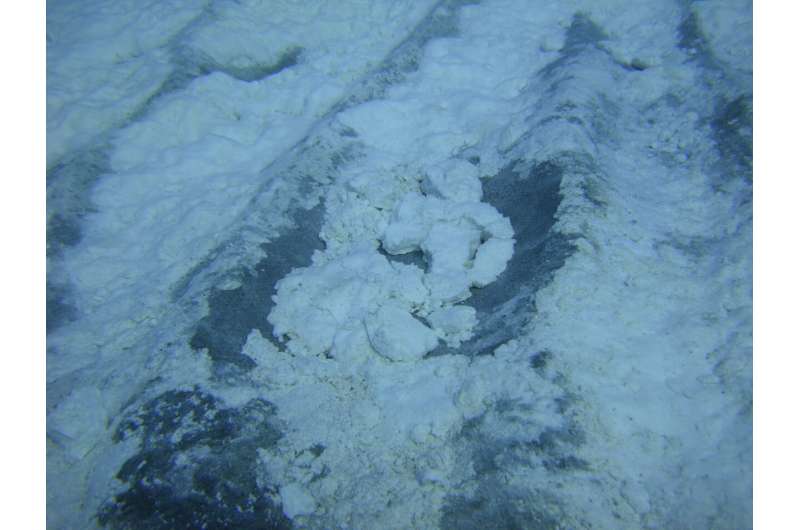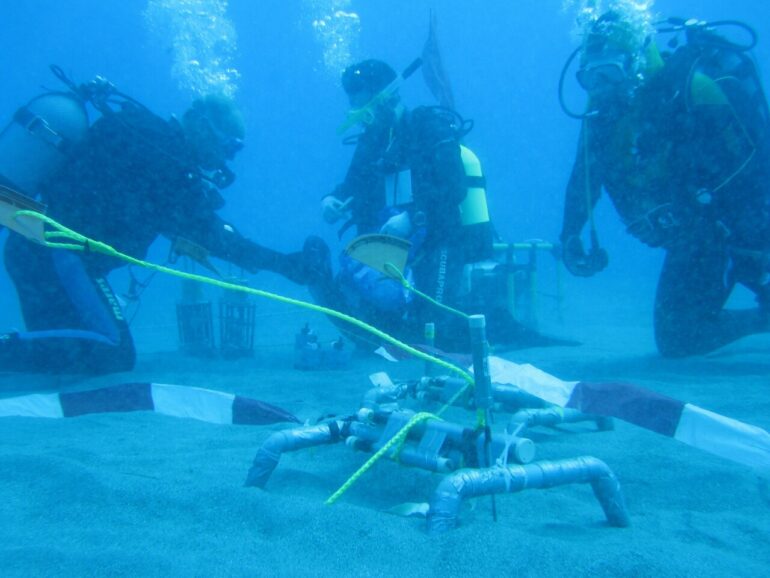Most visitors to Paliochori Beach on the Greek island Milos may not be aware of the bay’s shallow-water hydrothermal community, a veritable Greek salad of microbes, that is within snorkeling distance from the shoreline.
The hydrothermalism in the coastal sediments of Paliochori Bay strongly affects biogeochemical processes there and supports chemosynthesis, which allows certain microorganisms such as sulfur-oxidizing bacteria to use chemical energy rather than light, as photosynthetic plants or algae do, to convert carbon dioxide into cell material.
However, the impact of fluid flow on the composition of the microbial community and the rates of chemosynthetic production have been unknown because it is challenging to measure microbial processes under natural conditions, particularly in hydrothermal systems.
A new study uses an innovative approach to examine the bay’s shallow-water hydrothermal system and the production of microbes there in situ and near natural conditions as a model to assess the importance of hydrothermal fluid circulation on chemosynthesis.
By examining microbial communities directly within the hydrothermally-impacted sandy sediments in the bay, the study demonstrates “the importance of fluid flow in shaping the composition and activity of microbial communities of shallow-water hydrothermal vents, identifying them as hotspots of microbial activity,” according to the paper, “Fluid flow stimulates chemoautotrophy in hydrothermally influenced coastal sediments,” published in Communications Earth & Environment.
In addition, “the study shows how productive the shallow water hydrothermal vents actually are, and how quickly the microbes adapt to changing conditions,” says co-lead author Stefan Sievert, associate scientist in the Woods Hole Oceanographic Institution’s (WHOI’s) Biology Department.
During the study, researchers carried out two sets of stable isotope probing experiments using carbon dioxide labeled with the stable carbon isotope 13C as a tracer to determine the microbes’ capability for carbon fixation, which is the conversion of carbon dioxide into biomass. The study deployed incubation devices along a transect at a vent in the bay and injected the tracer at different depths into the sediment, either in open or closed fluid flow modes, and left the devices in place for either 6 hours or 24 hours before picking them up again.
The amount of carbon fixation was determined by measuring the incorporation of the labeled carbon dioxide into fatty acids, a key component making up the cell membrane, in combination with assessing the composition of the microbial community using DNA- and RNA-based approaches.
The study “extends the current knowledge on dark carbon fixation in coastal sandy sediments to those areas that are impacted by hydrothermal activity,” according to the paper. The researchers’ data reveal that active fluid flow at this sandy sediment shallow-water hydrothermal vent site sustains carbon fixation rates that are among the highest determined for coastal margin sediments, highlighting the influence of hydrothermalism in supporting chemoautotrophic production by supplying the required chemicals in the form of electron donors such as hydrogen sulfide, and acceptors such as oxygen.
Extrapolating the production at the studied vent site to the overall venting area in the bay of about 4 acres, 7 metric tons of carbon are produced there per year. “That is about the same annual production per area as a 4-acre corn field,” says Sievert.
The study also found a very active microbial community that is able to respond quickly to environmental changes. The chemosynthetic production at Milos is mainly driven by Campylobacteria, which dominated the communities in the open incubations, but declined in the closed incubations. Other bacteria, in particular Gammaproteobacteria, also increased in open flow incubations, while others, such as Deltaproteobacteria and Thermodesulfobacteria increased in closed incubations. In general, the community switched from a community dominated by chemosynthetic microbes to one with a higher proportion of heterotrophic microbes, i.e., microbes that use organic carbon for food, just as people do. The study found that the microbial community changed in response to different conditions within a matter of hours, which is very fast and took the investigators by surprise.

When conditions are calm, the mats can grow up to an inch in thickness. During storms, the mats get swept away, providing a mechanism to export the produced biomass to the surrounding ocean, where it can serve as food for organisms. © Dr. Roy Price, Stony Brook University
Making the microbe rate measurements and identifying the various microbes at the hydrothermal vent site was a collaborative effort. That collaboration included Sievert’s expertise in the use of the incubation device and identifying the microbes based on DNA- and RNA-based techniques. In addition, the lab of co-lead author Solveig Bühring, a researcher at the University of Bremen, contributed data on the incorporation of the labeled carbon dioxide into the microbes’ fatty acids.
“What drives me to do this research is my curiosity to understand how things work. I’m interested in knowing what the microbes are doing and how they are helping the ecosystem to function,” says Sievert.
“Each individual microbe is so small, yet their combined impact is so immense,” he adds. “Microbes are kind of the engines of our planet, basically driving all of the biogeochemical cycles, such as the nitrogen and sulfur cycles.”
More information:
Stefan M. Sievert et al, Fluid flow stimulates chemoautotrophy in hydrothermally influenced coastal sediments, Communications Earth & Environment (2022). DOI: 10.1038/s43247-022-00426-5
Provided by
Woods Hole Oceanographic Institution
Citation:
Fluid flow stimulates chemosynthesis in a ‘Greek salad’ of hydrothermal microbes (2022, April 22)



